A High Performance All-Textile Wearable Antenna for Wristband Application
Abstract
1. Introduction
1.1. Challenges and Related Research
1.2. The Proposed Work
2. Antenna Design Methodology
2.1. EBG Formation
2.2. The Proposed Integrated Design
3. Results and Discussion
3.1. Free-Space Simulation and Measurement Results
3.2. On-Body Simulation and Measurement Results
3.3. SAR Evaluation
4. Conclusions
Author Contributions
Funding
Institutional Review Board Statement
Data Availability Statement
Acknowledgments
Conflicts of Interest
References
- Lee, H.; Tak, J.; Choi, J. Wearable antenna integrated into military berets for indoor/outdoor positioning system. IEEE Antennas Wirel. Propag. Lett. 2017, 16, 1919–1922. [Google Scholar] [CrossRef]
- Sabti, H.A.; Thiel, D.V. Time multiplexing-star shape body sensor network for sports applications. In Proceedings of the 2014 IEEE Antennas and Propagation Society International Symposium (APSURSI), Toronto, ON, Canada, 11–17 July 2010; IEEE: Piscataway, NJ, USA, 2014; pp. 969–970. [Google Scholar]
- Hall, P.S.; Hao, Y. Antennas and Propagation for Body-Centric Wireless Communications; Artech House: Norwood, MA, USA, 2012. [Google Scholar]
- Faisal, F.; Zada, M.; Ejaz, A.; Amin, Y.; Ullah, S.; Yoo, H. A Miniaturized Dual-Band Implantable Antenna System for Medical Applications. IEEE Trans. Antennas Propag. 2020, 68, 1161–1165. [Google Scholar] [CrossRef]
- Bait-Suwailam, M.M.; Labiano, I.I.; Alomainy, A. Impedance enhancement of textile grounded loop antenna using high-impedance surface (HIS) for healthcare applications. Sensors 2020, 20, 3809. [Google Scholar] [CrossRef] [PubMed]
- World Health Organization. Available online: https://www.who.int/globalchange/summary/en/index5.html (accessed on 30 June 2020).
- Yilmaz, T.; Foster, R.; Hao, Y. Detecting vital signs with wearable wireless sensors. Sensors 2010, 10, 10837–10862. [Google Scholar] [CrossRef] [PubMed]
- Edwards, J. Medicine on the Move: Wearable devices supply health-care providers with the data and insights necessary to diagnose medical issues and create optimal treatment plans [Special Reports]. IEEE Signal Process. Mag. 2019, 36, 8–11. [Google Scholar] [CrossRef]
- Olshansky, S.J.; Carnes, B.A.; Yang, Y.C.; Miller, N.; Anderson, J.; Beltrán-Sánchez, H.; Ricanek, K. The Future of Smart Health. Computer 2016, 49, 14–21. [Google Scholar] [CrossRef]
- Otto, C.A.; Jovanov, E.; Milenkovic, A. A WBAN-based system for health monitoring at home. In Proceedings of the 2006 3rd IEEE/EMBS International Summer School on Medical Devices and Biosensors, Cambridge, MA, USA, 4–6 September 2006; IEEE: Piscataway, NJ, USA, 2006; pp. 20–23. [Google Scholar]
- Naranjo-Hernández, D.; Reina-Tosina, J.; Roa, L.M. Lessons Learned about the Design and Active Characterization of On-Body Antennas in the 2.4 GHz Frequency Band. Sensors 2020, 20, 224. [Google Scholar] [CrossRef]
- Mahfuz, M.H.; Islam, M.R.; Park, C.W.; Elsheikh, E.A.; Suliman, F.; Habaebi, M.H.; Malek, N.A.; Sakib, N. Wearable textile patch antenna: Challenges and future directions. IEEE Access 2022, 10, 38406–38427. [Google Scholar] [CrossRef]
- Ferreira, D.; Pires, P.; Rodrigues, R.; Caldeirinha, R.F. Wearable Textile Antennas: Examining the effect of bending on their performance. IEEE Antennas Propag. Mag. 2017, 59, 54–59. [Google Scholar] [CrossRef]
- Ashyap, A.Y.; Dahlan, S.H.B.; Abidin, Z.Z.; Rahim, S.K.A.; Majid, H.A.; Alqadami, A.S.; El Atrash, M. Fully fabric high impedance surface-enabled antenna for wearable medical applications. IEEE Access 2021, 9, 6948–6960. [Google Scholar] [CrossRef]
- El Atrash, M.; Abdalgalil, O.F.; Mahmoud, I.S.; Abdalla, M.A.; Zahran, S.R. Wearable high gain low SAR antenna loaded with backed all-textile EBG for WBAN applications. IET Microw. Antennas Propag. 2020, 14, 791–799. [Google Scholar] [CrossRef]
- Abdu, A.; Zheng, H.X.; Jabire, H.A.; Wang, M. CPW-fed flexible monopole antenna with H and two concentric C slots on textile substrate, backed by EBG for WBAN. Int. J. Microw. Comput.-Aided Eng. 2018, 28, e21505. [Google Scholar] [CrossRef]
- Mahmud, M.Z.; Islam, M.T.; Misran, N.; Kibria, S.; Samsuzzaman, M. Microwave imaging for breast tumor detection using uniplanar AMC based CPW-fed microstrip antenna. IEEE Access 2018, 6, 44763–44775. [Google Scholar]
- Ashyap, A.Y.; Abidin, Z.Z.; Dahlan, S.H.; Majid, H.A.; Kamarudin, M.R.; Alomainy, A.; Abd-Alhameed, R.A.; Kosha, J.S.; Noras, J.M. Highly efficient wearable CPW antenna enabled by EBG-FSS structure for medical body area network applications. IEEE Access 2018, 6, 77529–77541. [Google Scholar]
- Hertleer, C.; Van Laere, A.; Rogier, H.; Van Langenhove, L. Influence of relative humidity on textile antenna performance. Text. Res. J. 2010, 80, 177–183. [Google Scholar] [CrossRef]
- Sanchez-Montero, R.; Lopez-Espi, P.L.; Alen-Cordero, C.; Martinez-Rojas, J.A. Bend and moisture effects on the performance of a U-shaped slotted wearable antenna for off-body communications in an Industrial Scientific Medical (ISM) 2.4 GHz band. Sensors 2019, 19, 1804. [Google Scholar]
- Guan, C.E.; Fujimoto, T. Design of a Wideband L-Shape Fed Microstrip Patch Antenna Backed by Conductor Plane for Medical Body Area Network. Electronics 2020, 9, 21. [Google Scholar]
- Li, Z.; Tian, X.; Qiu, C.W.; Ho, J.S. Metasurfaces for bioelectronics and healthcare. Nat. Electron. 2021, 4, 382–391. [Google Scholar] [CrossRef]
- El Atrash, M.; Abdalla, M.A.; Elhennawy, H.M. A wearable dual-band low profile high gain low SAR antenna AMC-backed for WBAN applications. IEEE Trans. Antennas Propag. 2019, 67, 6378–6388. [Google Scholar] [CrossRef]
- Ashyap, A.Y.; Abidin, Z.Z.; Dahlan, S.H.; Majid, H.A.; Shah, S.M.; Kamarudin, M.R.; Alomainy, A. Compact and low-profile textile EBG-based antenna for wearable medical applications. IEEE Antennas Wirel. Propag. Lett. 2017, 16, 2550–2553. [Google Scholar] [CrossRef]
- Raad, H.R.; Abbosh, A.I.; Al-Rizzo, H.M.; Rucker, D.G. Flexible and compact AMC based antenna for telemedicine applications. IEEE Trans. Antennas Propag. 2012, 61, 524–531. [Google Scholar]
- Yalduz, H.; Koç, B.; Kuzu, L.; Turkmen, M. An ultra-wide band low-SAR flexible metasurface-enabled antenna for WBAN applications. Appl. Phys. A 2019, 125, 1–11. [Google Scholar] [CrossRef]
- Simorangkir, R.B.; Kiourti, A.; Esselle, K.P. UWB wearable antenna with a full ground plane based on PDMS-embedded conductive fabric. IEEE Antennas Wirel. Propag. Lett. 2018, 17, 493–496. [Google Scholar] [CrossRef]
- Le, T.T.; Yun, T.Y. Wearable dual-band high-gain low-SAR antenna for off-body communication. IEEE Antennas Wirel. Propag. Lett. 2021, 20, 1175–1179. [Google Scholar] [CrossRef]
- Martinez, I.; Mao, C.X.; Vital, D.; Shahariar, H.; Werner, D.H.; Jur, J.S.; Bhardwaj, S. Compact, low-profile and robust textile antennas with improved bandwidth for easy garment integration. IEEE Access 2020, 8, 77490–77500. [Google Scholar] [CrossRef]
- Abbasi, M.A.B.; Nikolaou, S.S.; Antoniades, M.A.; Stevanović, M.N.; Vryonides, P. Compact EBG-backed planar monopole for BAN wearable applications. IEEE Trans. Antennas Propag. 2016, 65, 453–463. [Google Scholar]
- Pirhadi, A.; Hakkak, M.; Keshmiri, F.; Baee, R.K. Design of compact dual band high directive electromagnetic bandgap (EBG) resonator antenna using artificial magnetic conductor. IEEE Trans. Antennas Propag. 2007, 55, 1682–1690. [Google Scholar]
- Haga, N.; Saito, K.; Takahashi, M.; Ito, K. Characteristics of cavity slot antenna for body-area networks. IEEE Trans. Antennas Propag. 2009, 57, 837–843. [Google Scholar] [CrossRef]
- Alomainy, A.; Hao, Y.; Owadally, A.; Parini, C.G.; Nechayev, Y.; Constantinou, C.C.; Hall, P.S. Statistical analysis and performance evaluation for on-body radio propagation with microstrip patch antennas. IEEE Trans. Antennas Propag. 2007, 55, 245–248. [Google Scholar] [CrossRef]
- Soh, P.J.; Vandenbosch, G.A.; Ooi, S.L.; Rais, N.H.M. Design of a broadband all-textile slotted PIFA. IEEE Trans. Antennas Propag. 2011, 60, 379–384. [Google Scholar] [CrossRef]
- Suma, M.; Bybi, P.; Mohanan, P. A wideband printed monopole antenna for 2.4-GHz WLAN applications. Microw. Opt. Technol. Lett. 2006, 48, 871–873. [Google Scholar] [CrossRef]
- Nechayev, Y.; Hall, P.; Hu, Z. Characterisation of narrowband communication channels on the human body at 2.45 GHz. IET Microw. Antennas Propag. 2010, 4, 722–732. [Google Scholar] [CrossRef]
- Rano, D.; Hashmi, M. Extremely compact EBG-backed antenna for smartwatch applications in medical body area network. IET Microw. Antennas Propag. 2019, 13, 1031–1040. [Google Scholar]
- Le, T.T.; Yun, T.Y. Miniaturization of a dual-band wearable antenna for WBAN applications. IEEE Antennas Wirel. Propag. Lett. 2020, 19, 1452–1456. [Google Scholar]
- Jiang, Z.H.; Brocker, D.E.; Sieber, P.E.; Werner, D.H. A compact, low-profile metasurface-enabled antenna for wearable medical body-area network devices. IEEE Trans. Antennas Propag. 2014, 62, 4021–4030. [Google Scholar]
- Ashyap, A.Y.; Dahlan, S.; Abidin, Z.; Kamarudin, M.; Majid, H.; Alduais, N.A.M.; Dahri, M.H.; Alhandi, S.A. C-shaped antenna based artificial magnetic conductor structure for wearable IoT healthcare devices. Wirel. Netw. 2021, 27, 4967–4985. [Google Scholar]
- Mohamadzade, B.; Hashmi, R.M.; Simorangkir, R.B.; Gharaei, R.; Ur Rehman, S.; Abbasi, Q.H. Recent advances in fabrication methods for flexible antennas in wearable devices: State of the art. Sensors 2019, 19, 2312. [Google Scholar] [CrossRef]
- Starodubov, A.V.; Serdobintsev, A.A.; Kozhevnikov, I.O.; Galushka, V.V.; Pavlov, A.M. Laser ablation and other manufacturing approaches for flexible antenna fabrication. In Proceedings of the Saratov Fall Meeting 2019: Laser Physics, Photonic Technologies, and Molecular Modeling, Saratov, Russia, 23–27 September 2019; SPIE: Bellingham, WA, USA, 2020; Volume 11458, pp. 11–15. [Google Scholar]
- El Gharbi, M.; Fernández-García, R.; Ahyoud, S.; Gil, I. A review of flexible wearable antenna sensors: Design, fabrication methods, and applications. Materials 2020, 13, 3781. [Google Scholar] [CrossRef]
- Godlinski, D.; Zichner, R.; Zöllmer, V.; Baumann, R.R. Printing technologies for the manufacturing of passive microwave components: Antennas. IET Microw. Antennas Propag. 2017, 11, 2010–2015. [Google Scholar] [CrossRef]
- Starodubov, A.V.; Galushka, V.V.; Serdobintsev, A.A.; Pavlov, A.M.; Korshunova, G.A.; Ryabukho, P.V.; Gorodkov, S.Y. A novel approach for fabrication of flexible antennas for biomedical applications. In Proceedings of the 2018 18th Mediterranean Microwave Symposium (MMS), Istanbul, Turkey, 31 October–2 November 2018; IEEE: Piscataway, NJ, USA, 2018; pp. 303–306. [Google Scholar]
- Gallucci, S.; Bonato, M.; Chiaramello, E.; Fiocchi, S.; Tognola, G.; Parazzini, M. Human Exposure Assessment to Wearable Antennas: Effect of Position and Interindividual Anatomical Variability. Int. J. Environ. Res. Public Health 2022, 19, 5877. [Google Scholar] [CrossRef]
- Mustafa, A.B.; Rajendran, T. Wearable multilayer patch antenna with electromagnetic band gap structure for public safety systems. IETE J. Res. 2022, 68, 2979–2988. [Google Scholar] [CrossRef]
- Singh, S.; Verma, S. Printed compact asymmetric dual L-strip fed split-ring shaped EBG-based textile antenna for WBAN applications. Microw. Opt. Technol. Lett. 2020, 62, 3897–3904. [Google Scholar] [CrossRef]
- Alemaryeen, A.; Noghanian, S. Crumpling effects and specific absorption rates of flexible AMC integrated antennas. IET Microw. Antennas Propag. 2017, 12, 627–635. [Google Scholar] [CrossRef]
- Cook, B.S.; Shamim, A. Utilizing wideband AMC structures for high-gain inkjet-printed antennas on lossy paper substrate. IEEE Antennas Wirel. Propag. Lett. 2013, 12, 76–79. [Google Scholar] [CrossRef]
- Saeed, S.M.; Balanis, C.A.; Birtcher, C.R.; Durgun, A.C.; Shaman, H.N. Wearable flexible reconfigurable antenna integrated with artificial magnetic conductor. IEEE Antennas Wirel. Propag. Lett. 2017, 16, 2396–2399. [Google Scholar] [CrossRef]
- Pei, R.; Leach, M.P.; Lim, E.G.; Wang, Z.; Song, C.; Wang, J.; Zhang, W.; Jiang, Z.; Huang, Y. Wearable EBG-Backed Belt Antenna for Smart On-Body Applications. IEEE Trans. Ind. Inform. 2020, 16, 7177–7189. [Google Scholar] [CrossRef]
- Joshi, R.; Hussin, E.F.N.M.; Soh, P.J.; Jamlos, M.F.; Lago, H.; Al-Hadi, A.A.; Podilchak, S.K. Dual-Band, Dual-Sense Textile Antenna With AMC Backing for Localization Using GPS and WBAN/WLAN. IEEE Access 2020, 8, 89468–89478. [Google Scholar] [CrossRef]
- Ashyap, A.Y.I.; Dahlan, S.H.B.; Abidin, Z.Z.; Dahri, M.H.; Majid, H.A.; Kamarudin, M.R.; Yee, S.K.; Jamaluddin, M.H.; Alomainy, A.; Abbasi, Q.H. Robust and Efficient Integrated Antenna With EBG-DGS Enabled Wide Bandwidth for Wearable Medical Device Applications. IEEE Access 2020, 8, 56346–56358. [Google Scholar] [CrossRef]


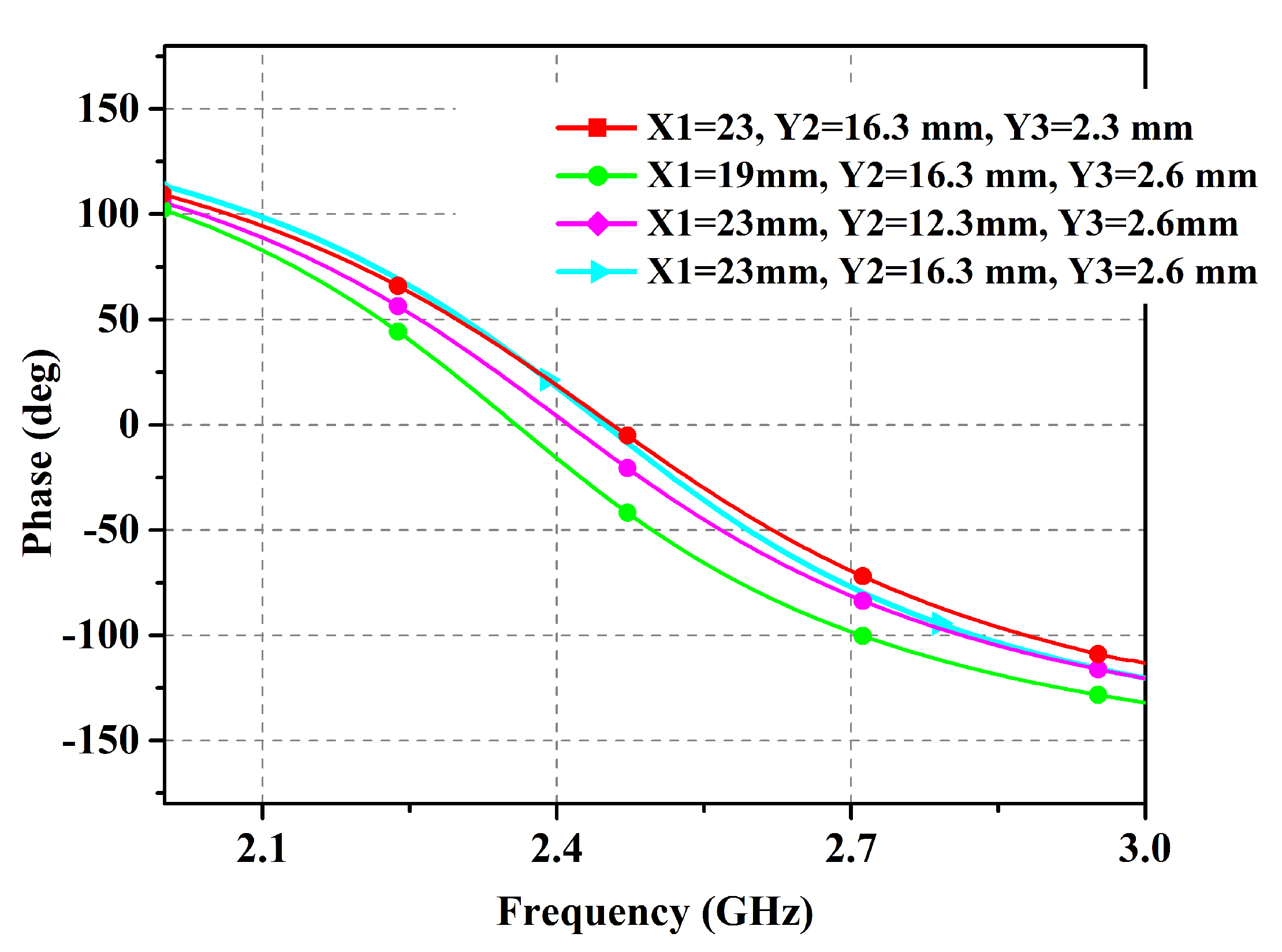

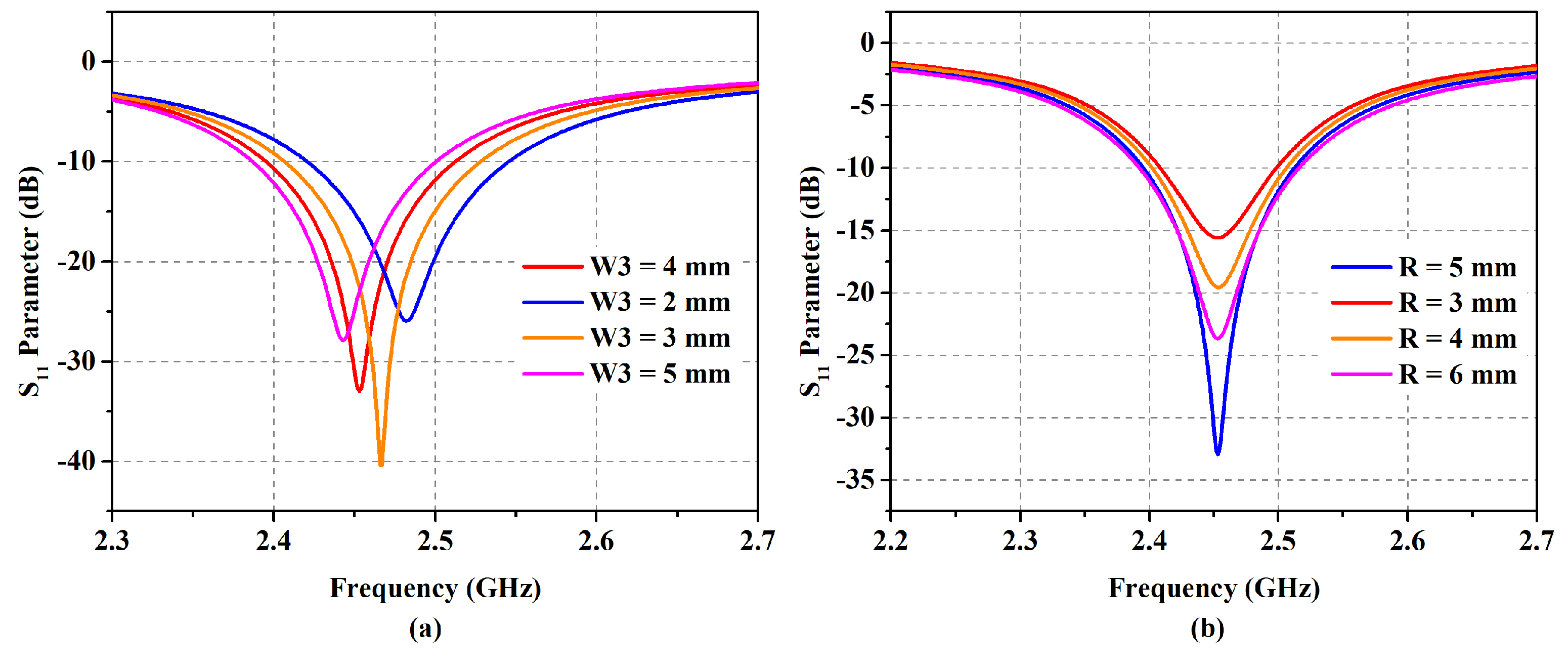
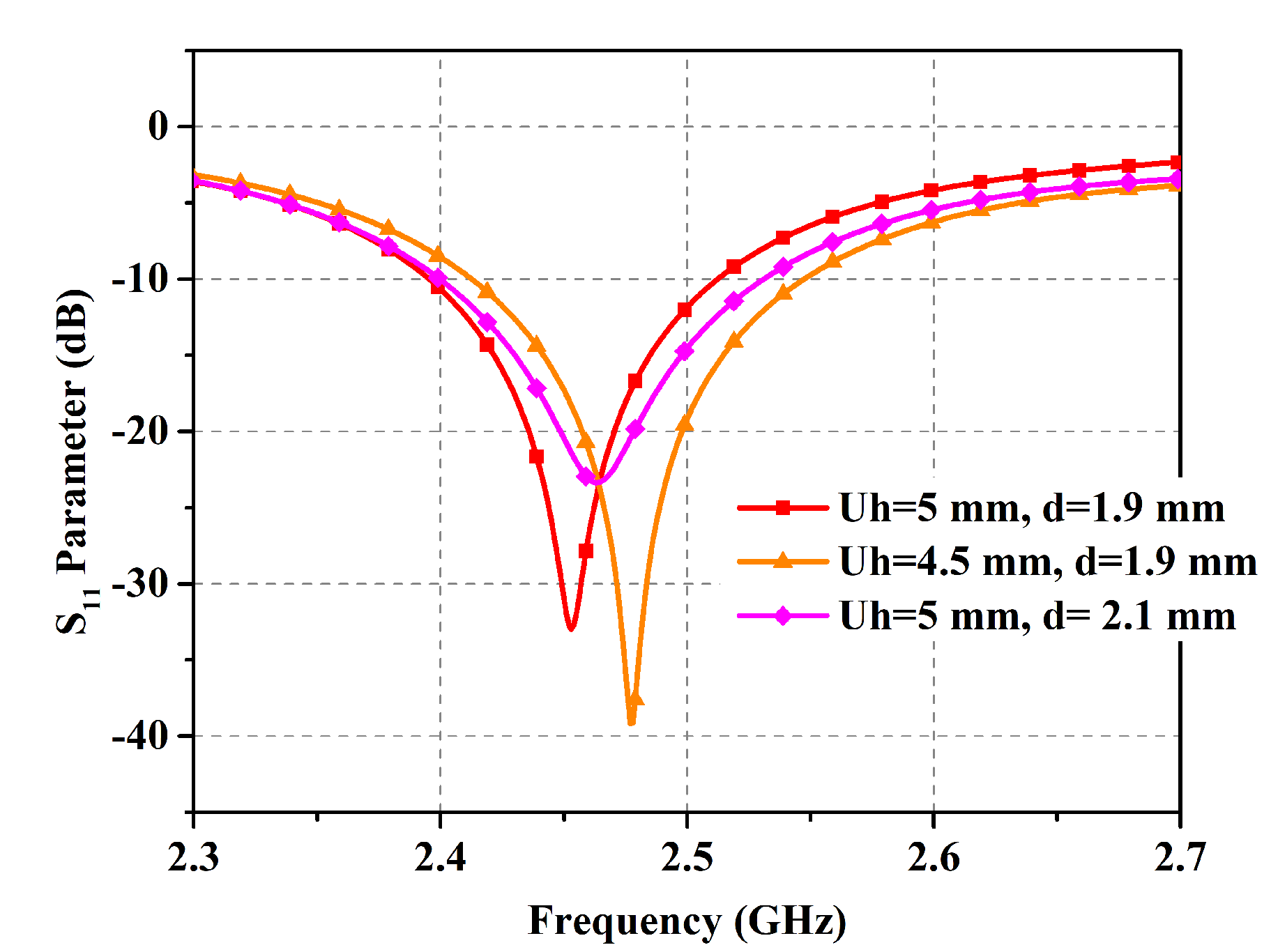

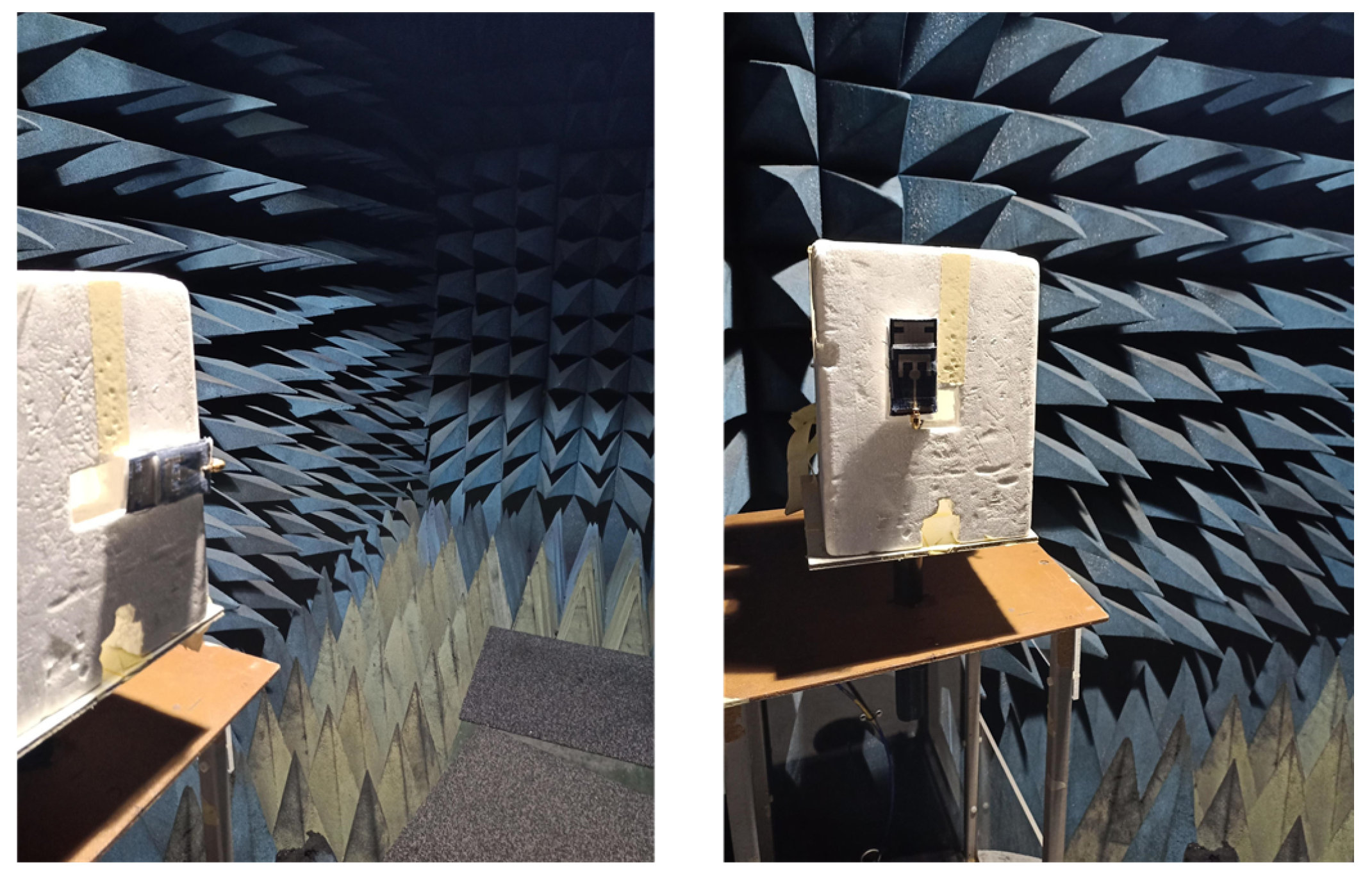
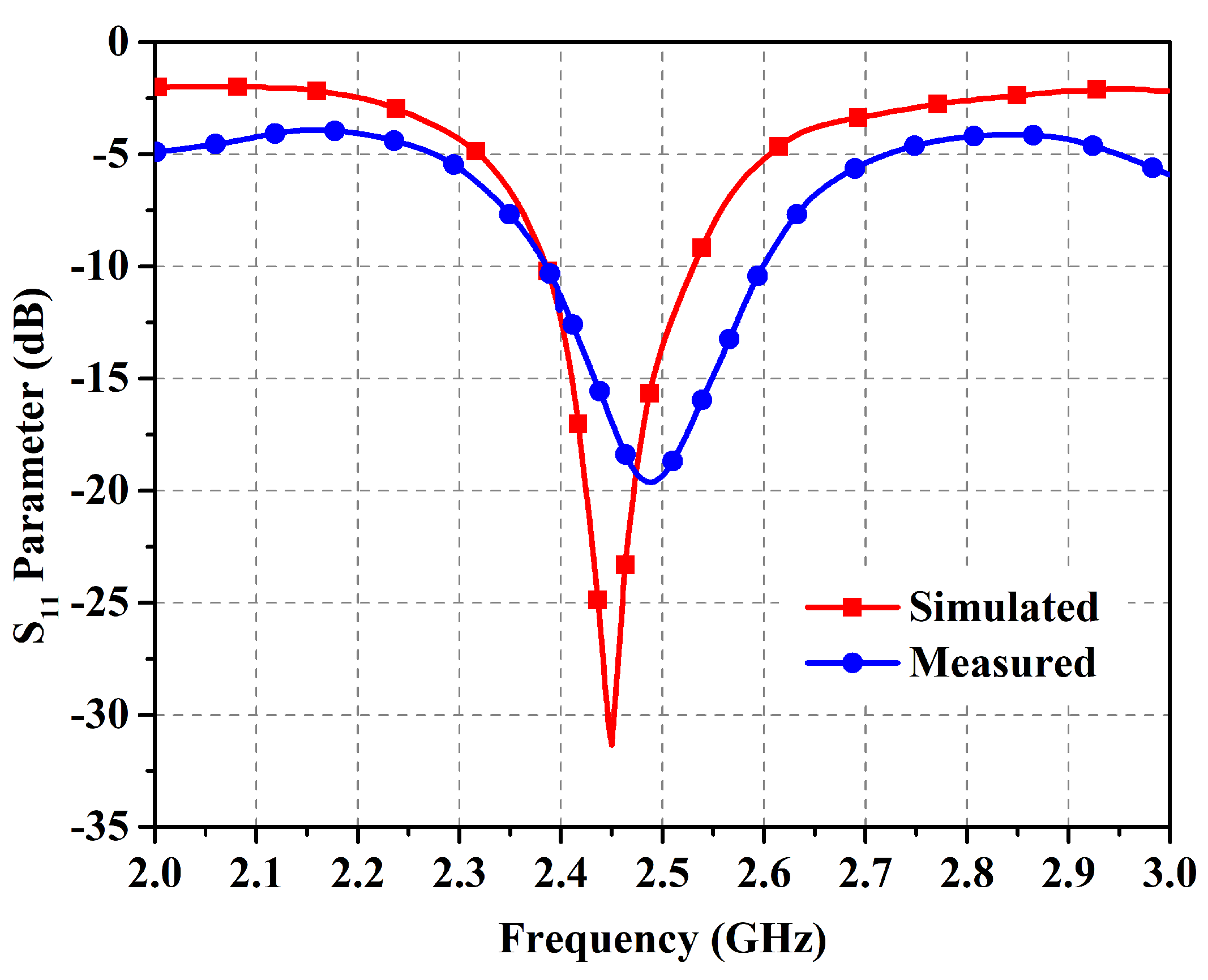
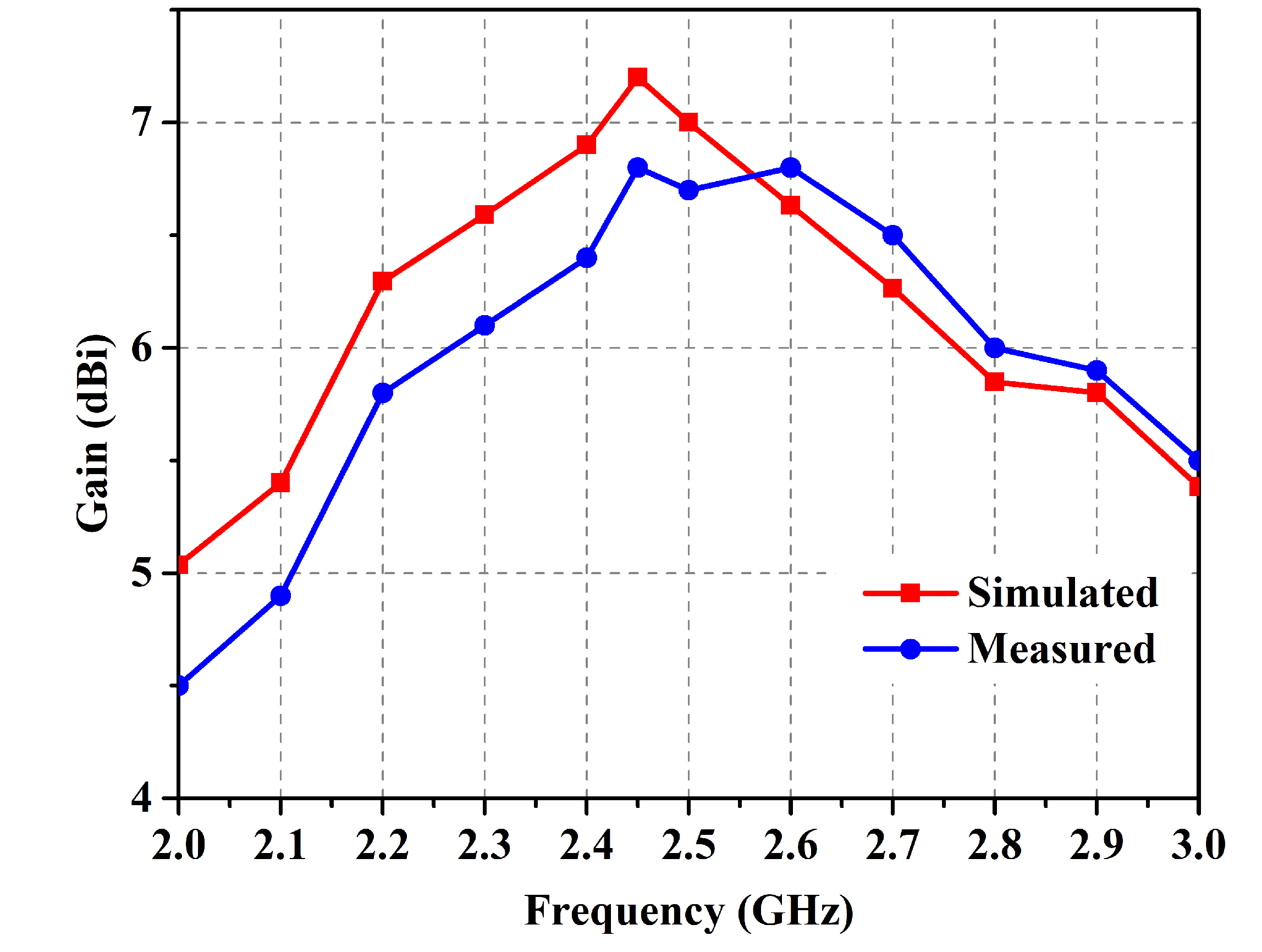
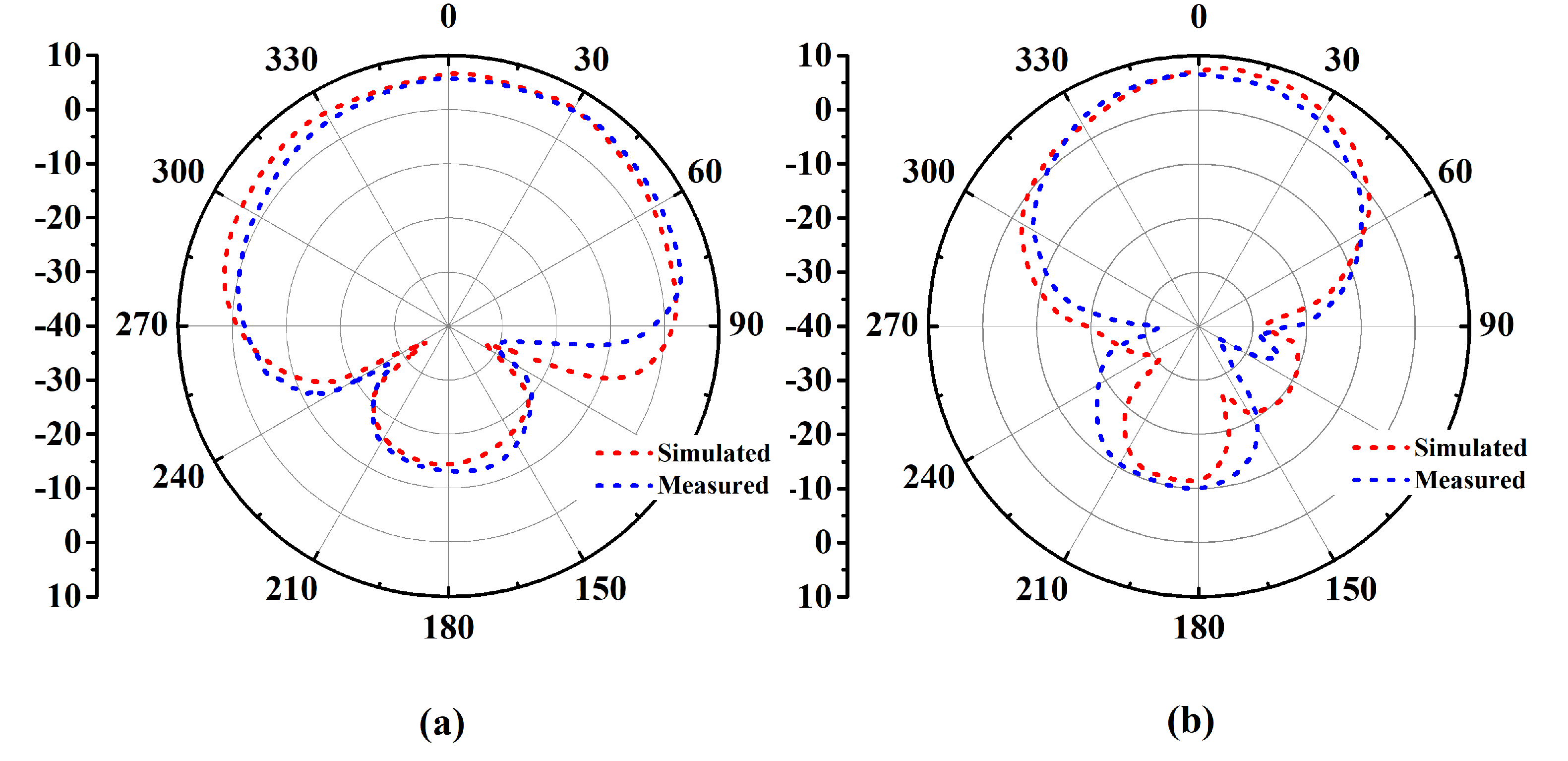


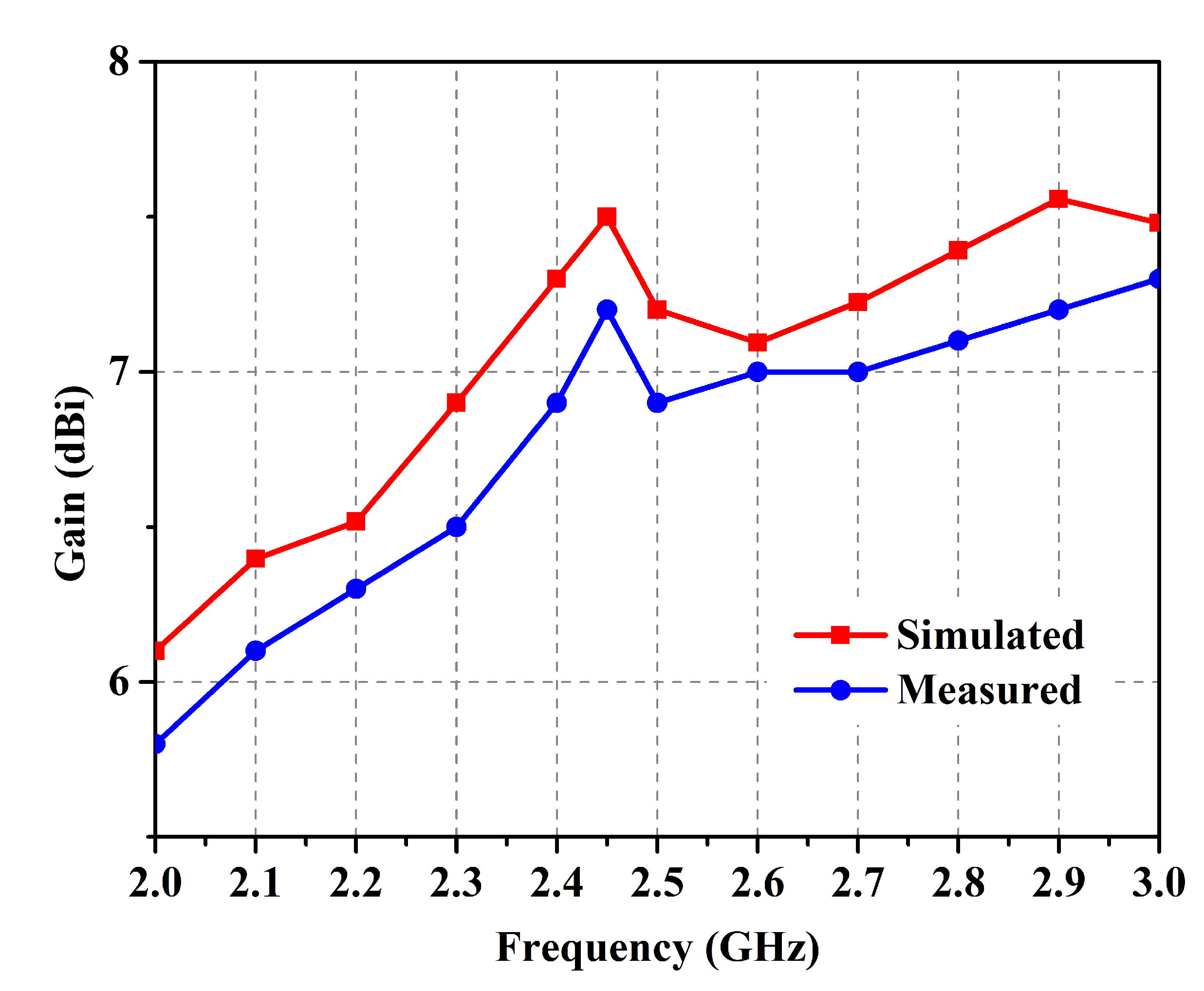
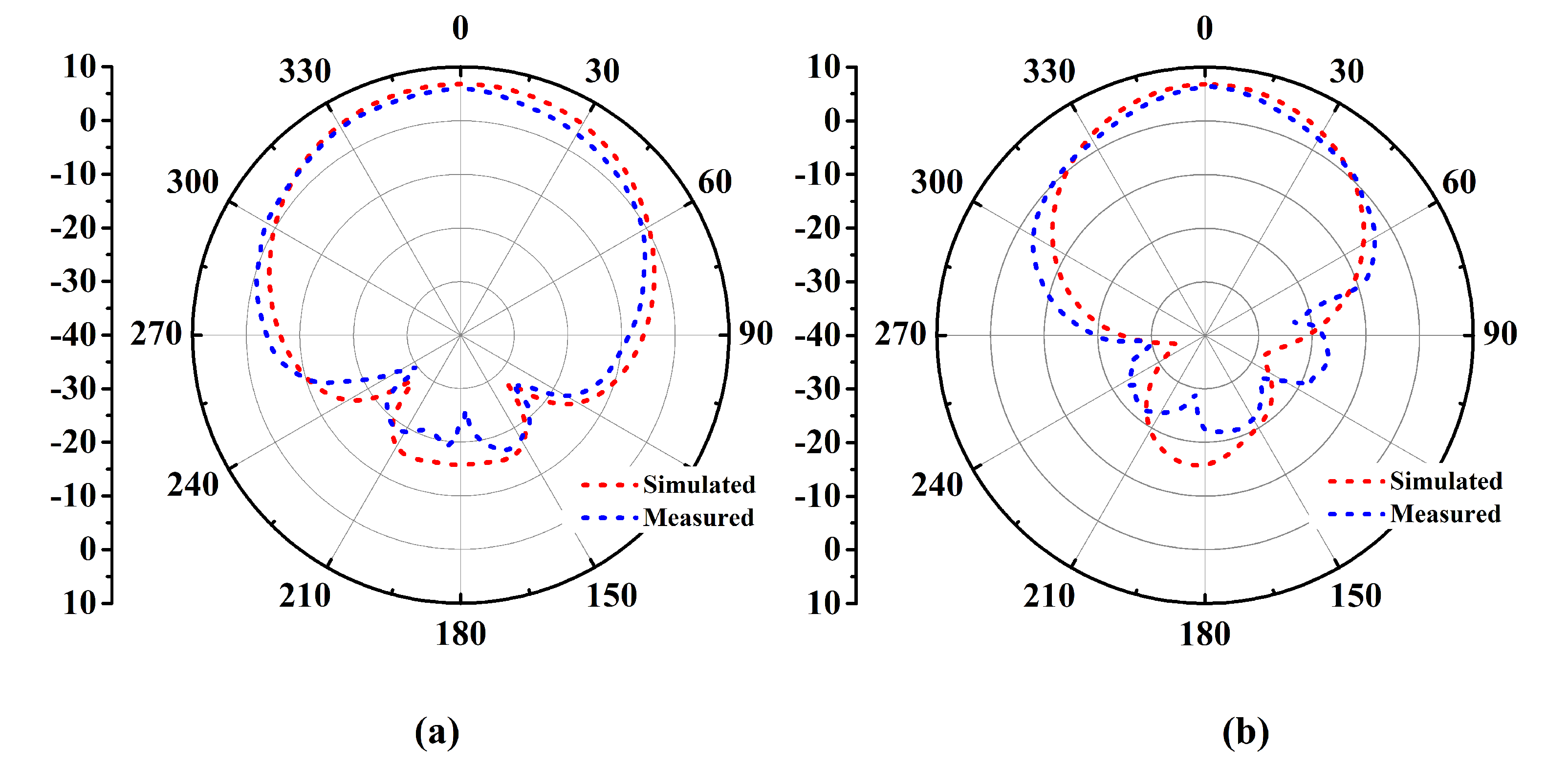
| References | Size (mm2) | Substrate | Reflector | No of Unit Cells | Gain (dB) |
|---|---|---|---|---|---|
| [47] | 42 × 30 | Felt | EBG | 4 × 3 | 6 |
| [48] | 40 × 20 | Textile | EBG | 2 × 1 | 4.48 |
| [49] | 124 × 124 | Rogers RO3003 | AMC | 4 × 4 | 8.4 |
| [50] | 50 × 50 | Latex | AMC | 3 × 3 | 1.81 |
| [14] | 45 × 45 | Fabric | HIS | 3 × 3 | 7.47 |
| [51] | 30 × 20 | Denim | - | - | 2.05 |
| [5] | 145 × 112 | Denim | HIS | 4 × 3 | 6.19 |
| [52] | 120 × 120 | Leather and textile | EBG | 3 × 3 | 7.98 |
| [53] | 81 × 81 | Felt | AMC | 3 × 3 | 7.3 |
| [54] | 60 × 60 | Fabric | EBG | 2 × 2 | 6.45 |
| The proposed work | 35.4 × 82.4 | Denim | EBG | 2 × 1 | 7.46 |
Disclaimer/Publisher’s Note: The statements, opinions and data contained in all publications are solely those of the individual author(s) and contributor(s) and not of MDPI and/or the editor(s). MDPI and/or the editor(s) disclaim responsibility for any injury to people or property resulting from any ideas, methods, instructions or products referred to in the content. |
© 2023 by the authors. Licensee MDPI, Basel, Switzerland. This article is an open access article distributed under the terms and conditions of the Creative Commons Attribution (CC BY) license (https://creativecommons.org/licenses/by/4.0/).
Share and Cite
Ejaz, A.; Jabeen, I.; Khan, Z.U.; Alomainy, A.; Aljaloud, K.; Alqahtani, A.H.; Hussain, N.; Hussain, R.; Amin, Y. A High Performance All-Textile Wearable Antenna for Wristband Application. Micromachines 2023, 14, 1169. https://doi.org/10.3390/mi14061169
Ejaz A, Jabeen I, Khan ZU, Alomainy A, Aljaloud K, Alqahtani AH, Hussain N, Hussain R, Amin Y. A High Performance All-Textile Wearable Antenna for Wristband Application. Micromachines. 2023; 14(6):1169. https://doi.org/10.3390/mi14061169
Chicago/Turabian StyleEjaz, Asma, Iqra Jabeen, Zia Ullah Khan, Akram Alomainy, Khaled Aljaloud, Ali H. Alqahtani, Niamat Hussain, Rifaqat Hussain, and Yasar Amin. 2023. "A High Performance All-Textile Wearable Antenna for Wristband Application" Micromachines 14, no. 6: 1169. https://doi.org/10.3390/mi14061169
APA StyleEjaz, A., Jabeen, I., Khan, Z. U., Alomainy, A., Aljaloud, K., Alqahtani, A. H., Hussain, N., Hussain, R., & Amin, Y. (2023). A High Performance All-Textile Wearable Antenna for Wristband Application. Micromachines, 14(6), 1169. https://doi.org/10.3390/mi14061169








